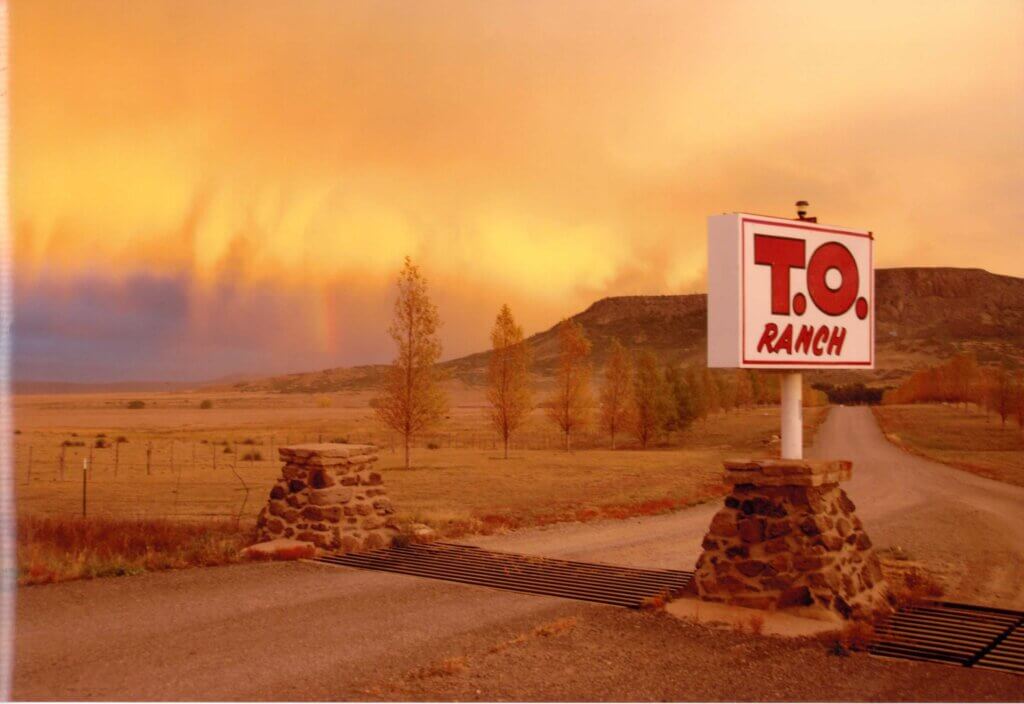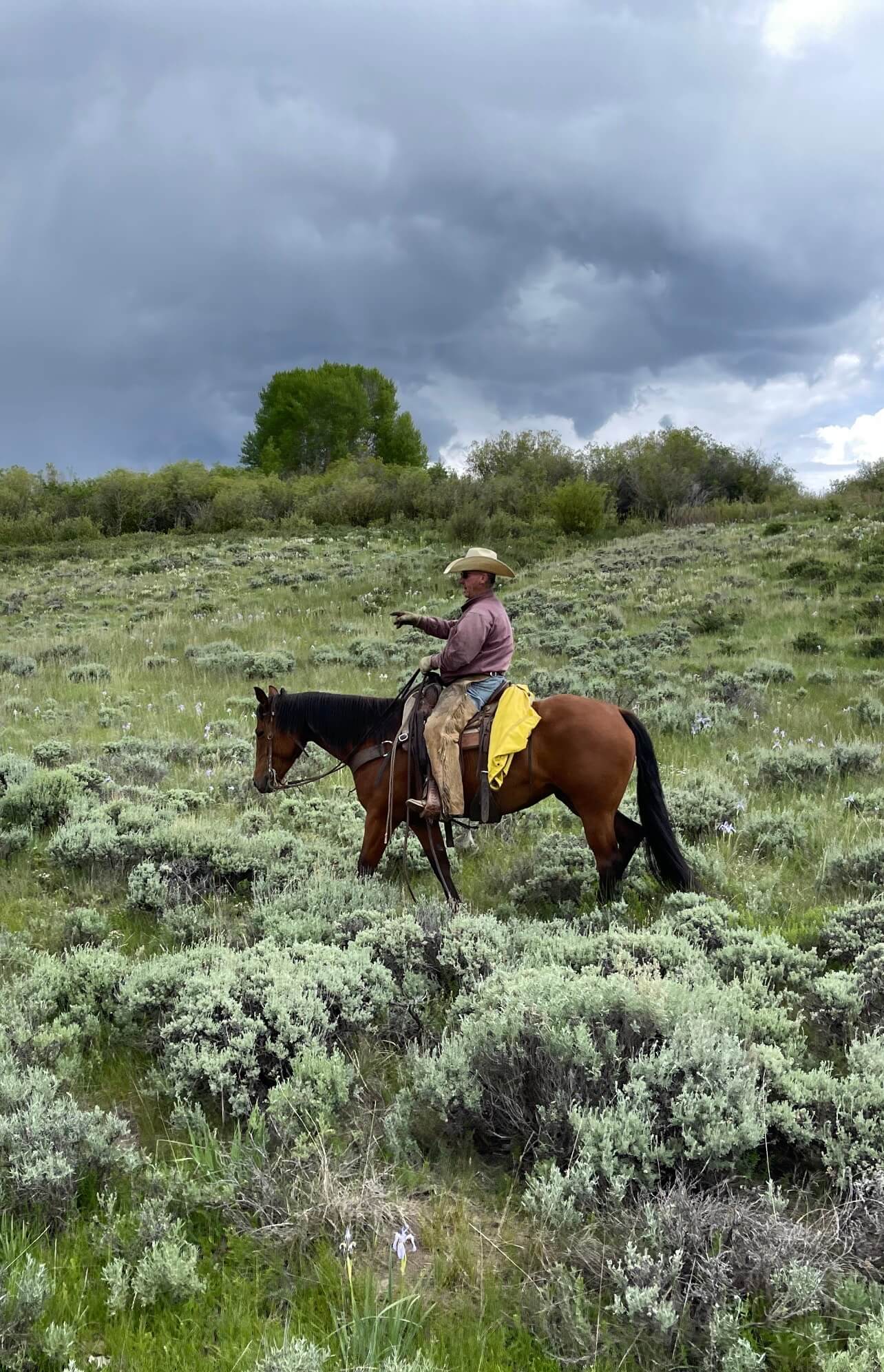A Brief History of the T.O. Ranch
Revised by Roger H. Long with the help of Wesly (Possom) Brown
President Abraham Lincoln’s first term was drawing to a close, as was the conflict between the states when the T.O. Ranch was founded in 1864.
Antoine J. Meloche came from Quebec Canada at the age of 14.
For several years he worked as a muleskinner on trains carrying supplies to Fort Union, 100 miles south of Raton, NM. In 1864, he took up a homestead on what is now the headquarters of the T.O. Ranch.
His home was what is now the TO Ranch office. According to stories handed down, he and his family were sometimes besieged by Indians, and prior to a “face-lifting job,” old bullet holes could be seen in the walls of the building, which is now the office. Mr. Meloche’s nickname was “Tony.” The first two letters in “Tony” T.O. are where the Brand and the Ranch name come from.
Alexander Thomas, a native of Scotland whose family was in the grain business and also friends of the Meloche family, came out west to visit the Meloche family in February of 1877. His love of the west and the rugged ranch life brought him back to spend several winters there.
On Feb. 15, 1883, when he was 27 years old, he purchased a half interest in the ranch for $10,000. At that time the ranch consisted of 480 acres.
Mr. Thomson moved shortly there after to Duluth Minn. at the head of Lake Superior, where he was associated for several years in the grain trade with C.A. Pillsbury of Minneapolis. He later formed his own firm, which became the lessee and operator of the Great Northern terminal elevator in the Duluth-Superior harbor.
As his Business interest grew, Mr. Thomson’s love for the ranch life also increased. In addition to acquiring the remaining half interest in the Meloche Ranch, he continued to systematically increase the acreage. By 1908 the total was more than 23,000 acres. In that year Tony Meloche Jr. was made ranch manager.
In 1906 the T.O. Ranch owners and management went to planning an earth dam to be built in the lower part of Johnson Park. First they needed a project engineer to draw up and design preliminary plans for the dam. Second they needed permits from the Territorial Government of New Mexico to build the dam. Third they needed to make sure all water rights acquired in the 1860’s were legal. Fourth there had to be a certain amount of acres under irrigation to receive the permit from the New Mexico Water Engineers to build the dam.
The Morse Brothers Machinery and Supply Co. supplied all of the equipment needed for this type of project. The men that worked on the dam lived at the dam site. It was called a tent city. Throttle Dam was completed in 1913.
Johnson Mesa is a 20-mile long mesa north of Throttle Dam. In 1890Johnson Mesa was open for homesteads, and people came from all parts of the world to homestead on the mesa. With a family on every 160 acres plowing up the ground to plant and grow their crops, a lotof topsoil was being washed down Taylor Canyon into the lake behind Throttle Dam. Therefore, todaythe lake’s capacityhas been reduced by several acre feet ofwater due to silt being washed into the lake.
In 1920 the ranch was incorporated only a short time before Alexander D. Thomson’s death. At that time, the T.O. consisted of 64,000 acres. As President and majority stockholder, Adam G. Thomson (a son of Alex. T.)contributed much money, time, and patience toward the building of an outstanding ranchfor the production of quality cattle. From 1921 to the time of his death in February 1955, the size and capacity of the ranch were doubled to approximately 128,000 acres.
According to past records, the decades of the 1930’s were mostly dry and the wind blew a lot of the time.However, there were some good things that came out the 30’s. In 1930, at the Denver Stock Show, the WyomingHereford Ranch showed a pen of firstplace bulls. One bull in thispen was Colorado Domino 68th. This bull and many otherswere the start of a reputation Hereford herd of cattle.By the late 30’s, feeders were buying TO steers, feeding them out, and winning many of the major stock shows.
The decade of the 1940’s brought lots of moisture, except 1949, which was a very dry year. By the 40’s TO Ranch steers were not only taking 1st place trophies, but were winning Grand Champions of the shows in Carlots or individuals. The TO steerswere winning shows in Denver, Dallas, Chicago, Omaha, the KansasCity American Royal,and others. In 1946, a TO bred steer won Grand Champion of the Kansas City American Royal, and brought 35.50 a pound for a total of
$43,026.00.
The decade of the 50’s was dry againand some of the commercial cows were shipped to the Flint Hills of Kansasto a ranch that had been leased for the summer grazingseason. TO Ranch bred steers were still winning major shows during the 50’s. In 1953, at the International in Chicago, theTO steers won the Carlot Champion as well as individual Champion.
In 1955, Adam G. Thomson passed away due to a heart attach at Miami Beach, FL. He was only 67 years old. His two sons Alexander and Adam took over the ranch after their father’s death. In November 1958, after spending a few days on the ranch,Adams’s plane went down outside of New Orleans, Louisiana, while on his way back to Florida.
Adam Thomson was 36 years old.
The decade of the 60’s brought about many changes for the TO Ranch.
On Aprill, 1962, Alexander Thomson sold the ranch to Jack Renfro from Hereford, Texas for 3.5 million dollars. After having the ranch for one year, Mr. Renfro passed away while on a fishing trip in Arkansas. In January of 1964, the estate of Jack Renfro sold 3500 head of both registered and commercial Herefords to the Little Horn Land and Livestock Co. from Wyola, Montana.Two special trains, with more than 100 cars, were used to transport the cattle to their new home in the
foothills of the Big Horn Mountainsin southeastern Montana.
In December 1964, T.L. Roach Jr. from Amarillo, TX purchased the TO Ranch from Mrs. Renfro. Mr. Roach started a herd of commercial Hereford cows, and during the early 70’s started putting black bulls on Herford cows. In 1971 and 72he sold about 25,000 acres from the TO Ranch. In 1978, Mr. Roach became sick and sold the ranch to Jim Whittenburg from Amarillo, TX.
In the early 1980’s, Mr. Whittenburg built more than 250 earth dams on the ranch, which really improved the livestock water. From 1984 to 1999 the ranch was leased out to several different operators who ran yearlings on the ranch. In 1997, Mr. Whittenburg’s helicopter went down north of Amarillo.He lost his wife in the wreck. He survived, but was badly burned. Two years later, he sold the ranch to John C. Malone from Parker, Colorado.
From May of 1999 to present, Mr.and Mrs. John C. Malone are
giving their best shot atgetting the ranch back to its original shape and beauty. In twoyears they have doubled the acreage to more than 200,000 acres. Our goal is to get a herd of terminal crossed bred cows, built up over the next three or four years. One of our main objectives is to wean a92 to 95% calf crop each year, and wean 600 to 6501b calves off of each cow.
We have addedan additional two centerpivots over the past two years, which should enable us to raise enough hay for our cows.
This has been a brief history of the last 138 years of the T.O. Ranch.



leave a comment!
Comments